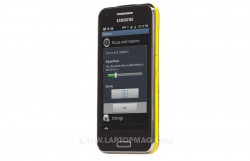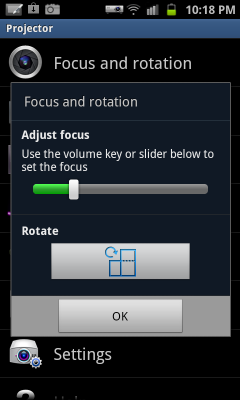Samsung Galaxy Beam Hands-On: An Android Phone and Projector in Your Pocket
Samsung is either the Dr. Frankenstein or Girl Talk of tech companies. With the Galaxy Camera, it combined a 21x zoom camera with an Android device, and with the Galaxy Beam, it smashed together a phone with a pico projector. The former is a somewhat compelling mishmash; is the Beam an equally successful pairing of two devices? We went hands-on to find out.
Kudos to Samsung for making a phone that’s something other than black. The Galaxy Beam has a yellow strip running around the middle, which gives it a sporty look, and certainly stands out among all the slabs on the market. Aside from the stripe, the other distinguishing feature of the Beam is the large lens on the top edge.
Measuring 4.9 x2.5 x0.49 inches and weighing 5.1 ounces, the Beam is a tad on the heavy side, but easy to grip in one hand, and certainly commendable given this phone has a projector built in. The gray soft-touch finish on the back certainly helps. The right side of the Beam has a button to activate the projector, a power switch, and a microSD card slot protected by a cover. The left side has a 3.5mm headphone jack, volume controls, and a SIM card slot, also protected by a plastic cover.
The Beam’s 4-inch, (800x480) TFT display isn't’ going to wow anyone, but it gets the job done. Same goes for its 1-GHz dual-core processor, 6GB of RAM, and 8GB of ROM. It's not going to compete with the S III, but we didn't notice any lag when using the phone.
Inside the Beam is a DLP projector with a rated brightness of 15 lumens, and with a resolution of 640 x 360. Suffice it to say, this isn’t the next coming of IMAX, but it’s fun for personal entertainment.
While watching the trailer for “Star Trek: Into Darkness,” the reds of the alien planets were vivid, but blues, such as Kirk’s Starfleet uniform, were muted. Contrast wasn’t all that great, but you have to temper your expectations somewhat on a projector this size.
At 3 feet, the Beam projected a 23-inch image with an average brightness of 80 lux. At 6 feet, the image expanded to 43 inches on the diagonal, but the average brightness dropped to 19.4 lux. At this distance, you’ll only want to use the Beam in a completely dark room.
Sign up to receive The Snapshot, a free special dispatch from Laptop Mag, in your inbox.
In the Projector app, Visual presenter mode lets you project whatever the Beam’s rear camera sees. In theory, this is a neat idea, but it’s undermined by two things. First, in order to see anything of importance, the projector’s lens needs to be pointed at the ceiling. Otherwise, the camera will be facing the ground. Second, the projector’s output is so dim, that you need to have the lights off in order to see anything. Of course, with the lights off, the camera has a much more difficult time picking anything up. It's a problem we also encountered with the ViewSonic DVP5 Pocket Camcorder Projector.
Also in the Projector app is Ambience mode. Here, you can select one of six different animations, from a disco ball to a single lit candle, as well as about a dozen different background music themes. When activated, the Beam will the project whatever you've selected, along with the accompanying music. It’s a fun little feature that will provide a few minutes of amusement.
Finally, the Torch Light feature lets you beam a solid color (white, red, green, or blue) and have it blink at various intervals. More than anything, it could be handy for emergency situations.
Samsung says the 2,000-mAh battery should provide up to 3 hours of continuous play time. Using the LAPTOP Battery Test (Web surfing via Wi-Fi) with the screen at 40 percent brightness and the projector on, the Beam lasted 3 hours and 37 minutes, and still had 13 percent left. When streaming a video from YouTube (also with the projector and the screen on), the Beam lasted 3 hours and 10 minutes.
While the Galaxy Beam isn’t available through any carrier in the U.S., you can find it online for anywhere from $490 to $590.
Overall, the Beam is an interesting idea. Who wouldn’t want to have a projector in their smartphone? However, its relative dimness limits its use to not much more than personal entertainment. There's not a lot of times when we wished we had a projector built right into our phone, and, for its unlocked price of around $500, would just as soon get a dedicated pico projector such as the ViewSonic PLED-W200. However, we like that Samsung is taking chances, and can't wait for its next mashup.
Michael was the Reviews Editor at Laptop Mag. During his tenure at Laptop Mag, Michael reviewed some of the best laptops at the time, including notebooks from brands like Acer, Apple, Dell, Lenovo, and Asus. He wrote in-depth, hands-on guides about laptops that defined the world of tech, but he also stepped outside of the laptop world to talk about phones and wearables. He is now the U.S. Editor-in-Chief at our sister site Tom's Guide, where he oversees all evergreen content and the Homes, Smart Home, and Fitness/Wearables categories for the site..



